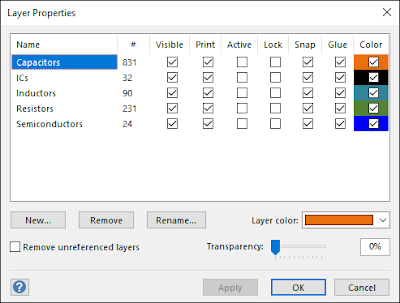Continuing with the layout diagram for the Gigabyte GeForce 8600 GT graphics card, I have completed the solder side (rear view) of the board. Again, for contrast, here's the negative photo:
And the Visio drafted diagram:
I have also created different layers for each category of components for better management and flexibility of display:
Notice that besides assigning colors to components belonging to layer, it also shows the number of objects (not components) on each layer. I say 'objects' because each component is made up of a number of basic shapes which are grouped together. And until I merged these shapes, Visio will count them as individual objects still.
At this point of my PCB-RE process, though, there's no need to do so. But having different components in their own layers enables me to turn on or off a group of components at will. And once I assign reference designators to them, it will be much easier to locate a particular component, especially since the PCB does not order them according to location placement. These are two of the advantages of using Visio to create PCB layout diagrams which are mentioned in my books.











No comments:
Post a Comment